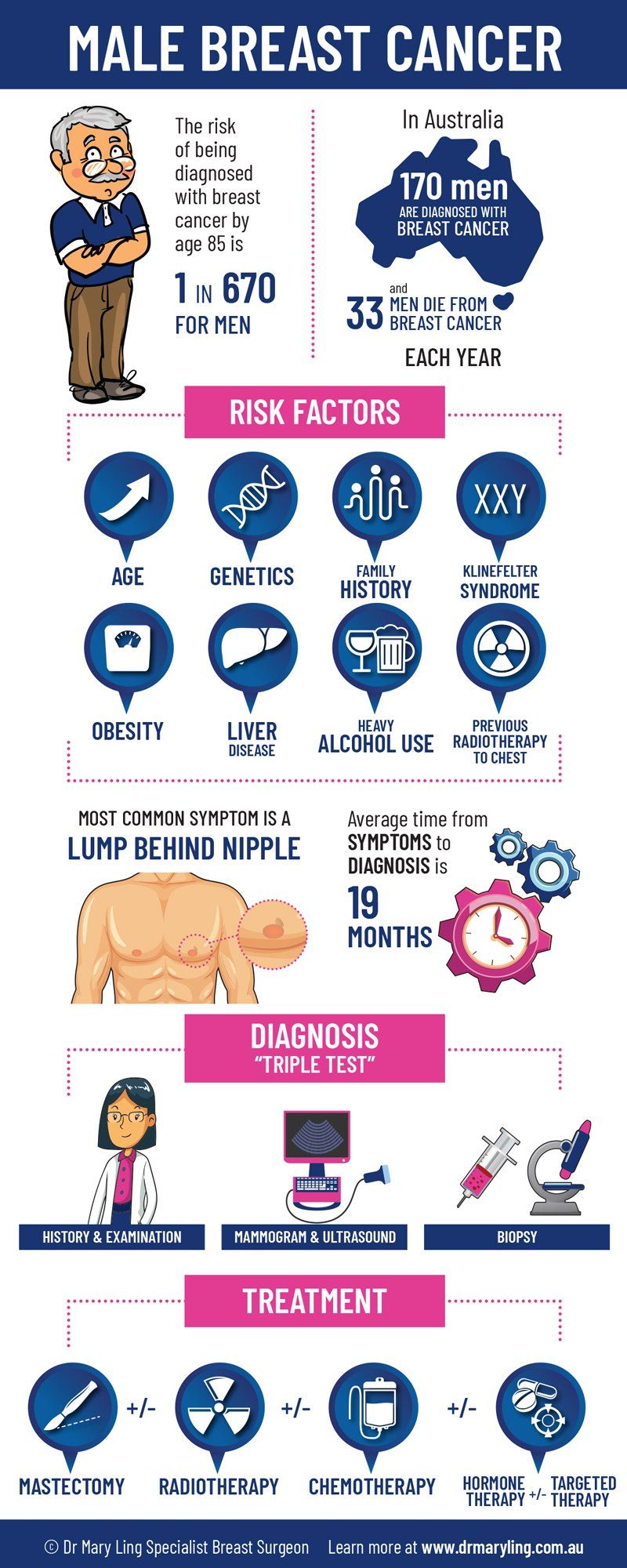BREAST CANCER IN MEN
Breast cancer in men is the same disease that affects women. Both men and women have breast tissue, although men have less breast tissue than women. Most of the breast tissue in men is located behind the nipple.
How common is breast cancer in men?
Breast cancer in men is a rare disease. Less than 1% of all breast cancers occur in men.
In Australia, it is estimated that 170 men are diagnosed with breast cancer each year and 33 men die from the disease. For men, the lifetime risk of being diagnosed with breast cancer is 1 in 670.
What causes breast cancer in men?
A number of factors can increase a man’s risk of developing breast cancer.
Growing Older
The incidence of breast cancer in men increases with age. It occurs more commonly in those aged 50 years and older, with the average age of diagnosis being 69.
High Oestrogen Levels
Breast growth, both normal and abnormal, is stimulated by the presence of oestrogen. Men can have high oestrogen levels as a result of
- Taking hormonal medicines
- Being overweight, which increases the production of oestrogen
- Heavy alcohol use, which can limit the liver’s ability to regular blood oestrogen levels
- Liver disease, which usually leads to lower levels of androgens (male hormones) and higher levels of oestrogen (female hormones) - this increases the risk of developing gynaecomastia (breast tissue growth that is non-cancerous) as well as breast cancer
Klinefelter’s Syndrome
Klinefelter’s syndrome is a rare condition affecting 1 in 500 to 1 in 1000 men. Men with Klinefelter’s syndrome have two X (female) chromosomes and one Y (male) chromosome (XXY) instead of a single X and single Y chromosome (XY). Men with Klinefelter syndrome have lower levels of androgens and higher levels of oestrogen. Therefore, they have a higher risk of developing gynaecomastia (breast tissue growth that is non-cancerous) and breast cancer.
Family History of Breast Cancer or Genetic Mutations
Family history can increase the risk of breast cancer in men, especially if other men in the family have had breast cancer. The risk is also higher if there is a proven breast cancer gene abnormality in the family. The lifetime risk of developing breast cancer is approximately 1% in men with a BRCA1 gene mutation and 6% in men with a BRCA2 gene mutation. The majority of male breast cancers still happen in men who have no family history of breast cancer and no inherited gene abnormality.
Previous Radiotherapy to the Chest
Men who have been treated with radiotherapy to the chest, usually for lymphoma, have an increased risk of developing breast cancer.
What are the symptoms and signs of male breast cancer?
The most common sign of breast cancer in men is a painless lump in the breast close to the nipple. Men have less breast tissue, so a lump is often easier to detect. The Know Your Lemons diagram shows the 12 warning signs of breast cancer. Not all changes are due to cancer, but it is important to see your doctor without delay if you notice new or unusual breast changes. Enlargement of both breasts, known as gynaecomastia, is usually not due to cancer.
Breast cancer in men tends to be more advanced at diagnosis compared to breast cancer in women. Research has also shown the average time between first symptom and diagnosis in male breast cancer to be 19 months! This is likely due to men not being routinely screened for breast cancer and a lack of awareness that breast cancer can happen in men.
What is the most common type of breast cancer in men?
Most breast cancers in men are oestrogen receptor positive invasive ductal carcinoma. This is also the most common breast cancer in women.
How is male breast cancer diagnosed?
The triple test is used to investigate breast changes in men. The triple test refers to 3 diagnostic components: medical history and clinical breast examination, imaging with mammogram and ultrasound, and biopsy. Not all men will require all of these tests.
What is the treatment for male breast cancer?
The main surgical treatment for breast cancer in men is mastectomy, which involves removal of the whole breast including the nipple. The pectoralis muscles under the breast do not need to be removed. Breast conserving surgery
(also called lumpectomy or wide local excision), which involves removing only the cancer with a rim of normal tissue, is usually not suitable for men because there is not enough breast tissue in the male breast. The lymph nodes in the armpit are usually sampled at the same time the mastectomy is performed - either with sentinel lymph node biopsy
or axillary lymph node dissection.
Radiotherapy, chemotherapy, targeted therapy
and/or endocrine therapy
may also be required after surgery.
Men diagnosed with breast cancer should be referred to a family cancer clinic for genetic counselling and testing. Male breast cancer is closely associated with BRCA1 and BRCA2 gene mutations. Identifying a gene mutation can influence screening recommendations for other types of cancers (such as prostate cancer), lead to testing of family members and identify treatment opportunities for men with metastatic breast cancer.
What is the prognosis for male breast cancer?
Breast cancer in men can be treated successfully. The majority of men diagnosed and treated for early breast cancer will not die from the disease. The prognosis for men with breast cancer is similar to that for women at the same age and stage of cancer.
Useful Resources
Men Get Breast Cancer Too
by Breast Cancer Network Australia



